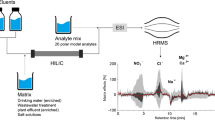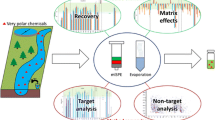Abstract
The aim of the study was to evaluate the performance of different chromatographic approaches for the liquid chromatography/mass spectrometry (LC-MS(/MS)) determination of 24 highly polar pesticides. The studied compounds, which are in most cases unsuitable for conventional LC-MS(/MS) multiresidue methods were tested with nine different chromatographic conditions, including two different hydrophilic interaction liquid chromatography (HILIC) columns, two zwitterionic-type mixed-mode columns, three normal-phase columns operated in HILIC-mode (bare silica and two silica-based chemically bonded columns (cyano and amino)), and two standard reversed-phase C18 columns. Different sets of chromatographic parameters in positive (for 17 analytes) and negative ionization modes (for nine analytes) were examined. In order to compare the different approaches, a semi-quantitative classification was proposed, calculated as the percentage of an empirical performance value, which consisted of three main features: (i) capacity factor (k) to characterize analyte separation from the void, (ii) relative response factor, and (iii) peak shape based on analytes’ peak width. While no single method was able to provide appropriate detection of all the 24 studied species in a single run, the best suited approach for the compounds ionized in positive mode was based on a UHPLC HILIC column with 1.8 μm particle size, providing appropriate results for 22 out of the 24 species tested. In contrast, the detection of glyphosate and aminomethylphosphonic acid could only be achieved with a zwitterionic-type mixed-mode column, which proved to be suitable only for the pesticides detected in negative ion mode. Finally, the selected approach (UHPLC HILIC) was found to be useful for the determination of multiple pesticides in oranges using HILIC-ESI-MS/MS, with limits of quantitation in the low microgram per kilogram in most cases.

HILIC improves separation of multiclass polar pesticides


Similar content being viewed by others
References
Botitsi HV, Garbis SD, Economou A, Tsipi DF. Current mass spectrometry strategies for the analysis of pesticides and their metabolites in food and water matrices. Mass Spectrom Rev. 2011;30:907–39.
Malik AK, Blasco C, Picó Y. Liquid chromatography-mass spectrometry in food safety. J Chromatogr A. 2010;1217:4018–40.
Anastassiades M, Kolberg DI, Eichorn E, Benkestein A, Lukacevic S, Mack D et al. Quick method for the analysis of residues of numerous highly polar pesticides in foods of plant origin involving simultaneous extraction with methanol and LC-MS/MS determination (QuPPe-Method) Version 8.0, http://www.crl-pesticides.eu/ Accessed Feb 2016
Alpert AJ. Hydrophilic-interaction chromatography for the separation of peptides, nucleic acids and other polar compounds. J Sep Sci. 2006;29:1784–821 [10].
Gama MR, da Costa Silva RG, Collins CH, Bottoli CGG. Hydrophilic interaction chromatography. Trends Anal Chem. 2012;37:48–60.
Buszewski B, Noga S. Hydrophilic interaction liquid chromatography (HILIC)—a powerful separation technique. Anal Bioanal Chem. 2012;402:231–47.
Jandera P. Stationary and mobile phases in hydrophilic interaction chromatography: a review. Anal Chim Acta. 2011;692:1–25.
Bernal J, Ares AM, Pól J, Wiedmer SK. Hydrophilic interaction liquid chromatography in food analysis. J Chromatogr A. 2011;1218:7438–52.
van Nuijs ALN, Tarcomnicu I, Covaci A. Application of hydrophilic interaction chromatography for the analysis of polar contaminants in food and environmental samples. J Chromatogr A. 2011;1218:5964–74.
Liu X, Pohl C, Woodruff A, Chen J. Chromatographic evaluation of reversed-phase/anion-exchange/cation-exchange trimodal stationary phases prepared by electrostatically driven self-assembly process. J Chromatogr A. 2011;1218:3407–12.
Liu X, Pohl CA. Comparison of reversed-phase/cation-exchange/anion-exchange trimodal stationary phases and their use in active pharmaceutical ingredient and counterion determinations. J Chromatogr A. 2012;1232:190–5.
Kazarian AA, Taylos MR, Haddad PR, Nesterenko PV, Paull B. Single column comprehensive analysis of pharmaceutical preparations using dual-injection mixed-mode (ion-exchange and reversed-phase) and hydrophilic interaction liquid chromatography. J Pharm Biomed Anal. 2013;86:174–81.
Kazarian AA, Nesterenko PN, Soisungnoen P, Burakham R, Srijaranai S, Paull B. Comprehensive analysis of pharmaceutical products using simultaneous mixed-mode (ion-exchange/reversed-phase) and hydrophilic interaction liquid chromatography. J Sep Sci. 2014;37:2138–44.
Aramendía MA, Borau V, Lafont F, Marinas A, Marinas JM, Moreno JM, et al. Determination of diquat and paraquat in olive oil by ion-pair liquid chromatography-electrospray ionization mass spectrometry (MRM). Food Chem. 2006;97:181–8.
Esparza X, Moyano E, Galceran MT. Analysis of chlormequat and mepiquat by hydrophilic interaction chromatography coupled to tandem mass spectrometry in food samples. J Chromatogr A. 2009;1216:4402–6.
Hao C, Zhao X, Morse D, Yang P, Taguchi V, Morra F. Optimized liquid chromatography tandem mass spectrometry approach for the determination of diquat and paraquat herbicides. J Chromatogr A. 2013;1304:169–76.
Hengel MJ, Jordan R, Maguire W. Development and validation of a standardized method for the determination of morpholine residues in fruit commodities by liquid chromatography/mass spectrometry. J Agric Food Chem. 2014;62:3697–701.
Gao J, Wang J, Zuo M, Ma L, Cui Y, Yang T, et al. A highly sensitive method for simultaneous determination of the quaternary ammonium pesticides chlormequat and mepiquat in pears and potatoes by modified QuEChERS-high performance liquid chromatography tandem mass spectrometry. RSC Adv. 2015;5:5895–903.
Guidance document on analytical quality control and method validation procedures for pesticides residues analysis in food and feed. European Commission, 2015, SANTE/11945/2015.http://www.eurlpesticides.eu Accessed Feb 2016
Whitehead RD, Montesano MA, Jayatilaka NK, Buckley B, Winnik B, Needham LL, et al. Method for measurement of the quaternary amine compounds paraquat and diquat in human urine using high-performance liquid chromatography-tandem mass spectrometry. J Chromatogr B. 2010;878:2548–53.
Botero-Coy AM, Ibáñez M, Sancho JV, Hernández F. Direct liquid chromatography-tandem mass spectrometry determination of underivatized glyphosate in rice, maize and soybean. J Chromatogr A. 2013;1313:157–65.
Yoshioka N, Asano M, Kuse A, Mitsuhashi T, Nagasaki Y, Ueno Y. Rapid determination of glyphosate, glufosinate, bialaphos, and their major metabolites in serum by liquid chromatography-tandem mass spectrometry using hydrophilic interaction chromatography. J Chromatogr A. 2011;1218:3675–80.
Kolberg DIS, MacK D, Anastassiades M, Hetmanski MT, Fussell RJ, Meijer T, et al. Development and independent laboratory validation of a simple method for the determination of paraquat and diquat in potato, cereals and pulses. Anal Bioanal Chem. 2012;404:2465–74.
Ekpe A, Tong JH, Rodriguez L. High performance liquid chromatographic method development and validation for the simultaneous quantitation of naproxen sodium and pseudoephedrine hydrochloride impurities. J Chromatogr Sci. 2001;39:81–6.
Regulation (EC) n° 396/2005 of the European parliament and of the council of 23 February 2005 on maximum residue levels of pesticides in or on food and feed of plant and animal origin and amending Council Directive 91/414/EEC
Pesticides MRLs database on European commission Website: http://ec.europa.eu/sanco_pesticides/public/index.cfm?event=homepage&language=EN. Accessed Sept 2015
Wang L, Fei T, Qi D, Sha Y, Wu D, Liu B. Development of microwave-assisted extraction and liquid chromatography-tandem mass spectrometry for determination of maleic hydrazide residues in tobacco. Anal Methods. 2015;7:5103–7.
Acknowledgments
The authors acknowledge funding from Junta de Andalucía through Research Project Ref. AGR-6182 and Research Group FQM323, and the Spanish Ministerio de Economía y Competitividad (MINECO) through Project Ref. CTQ-2015-71321, partially co-financed with FEDER funds. A.V. acknowledges the financial help to the Campus Hungary scholarship program (grant No. B1/1SZ/3704). J.R.M. also acknowledges funding from Plan Propio de Investigación of Universidad de Jaén (Ref. 2015/00018/001). B.G.L. acknowledges MINECO for her Juan de la Cierva postdoctoral research contract (ref. JCI-2012-12972).
Author information
Authors and Affiliations
Corresponding author
Ethics declarations
The research in this manuscript did not involve human participants and/or animals. All authors of this manuscript were informed and agreed for submission.
Conflict of interest
The authors declare that they have no competing interests.
Additional information
Published in the topical collection featuring Young Investigators in Analytical and Bioanalytical Science with guest editors S. Daunert, A. Baeumner, S. Deo, J. Ruiz Encinar, and L. Zhang.
Electronic supplementary material
Below is the link to the electronic supplementary material.
ESM 1
(PDF 2.40 mb)
Rights and permissions
About this article
Cite this article
Vass, A., Robles-Molina, J., Pérez-Ortega, P. et al. Study of different HILIC, mixed-mode, and other aqueous normal-phase approaches for the liquid chromatography/mass spectrometry-based determination of challenging polar pesticides. Anal Bioanal Chem 408, 4857–4869 (2016). https://doi.org/10.1007/s00216-016-9589-6
Received:
Revised:
Accepted:
Published:
Issue Date:
DOI: https://doi.org/10.1007/s00216-016-9589-6




